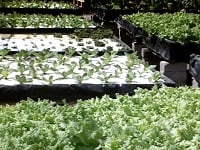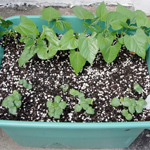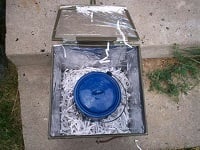Jlooney921 (talk | contribs) |
Jlooney921 (talk | contribs) |
||
| Line 192: | Line 192: | ||
</gallery> | </gallery> | ||
{{#widget:YouTube|id=wnZIvEl7zr4}} | |||
===Workshop Model=== | ===Workshop Model=== | ||
Revision as of 02:03, 13 May 2013
Abstract
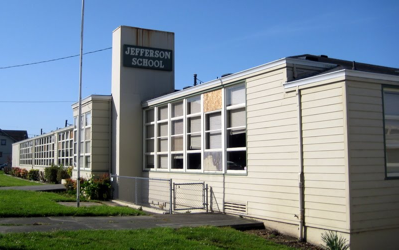
For our project we were tasked with planning and hosting a community workshop at the Jefferson Community Center in Eureka, California. As we began our planning, we took into account several factors. These included things like cost of the workshop, ease of execution, and acceptance of the topic by community members. We hosted a vote between several topics on the Jefferson Community Center Facebook page. The results led us to plan our workshop around alternative cooking methods. After brainstorming many methods, we decided to pursue the construction and use of retained heat cookers. Our prototype model worked well, but was too difficult to build and far too expensive. We then developed a working model for the workshop using cardboard boxes, foil, newspapers and a Mylar emergency blanket. These models worked effectively and were easy to create. We hosted the workshop at 1 PM on April 13th, 2013. Unfortunately we only had 1 attendee. We were successful in educating them about the benefits of retained heat cooking as well as the creation of their own retained heat cooker. On May 4th, 2013, we served food made with a retained heat cooker on a community volunteer day. This event was successful because it allowed us to educate many people about the benefits of retained heat cooking, and we offered brief explanations on creating their own retained heat cookers.
Background
The Jefferson Community Center Workshop project, part of HSU's ENGR 305 class, is aimed at bringing sustainable technology to the local community.The Project will revolve around the creation, and implementation of a community workshop at the Jefferson Community Center in Eureka, California. Currently there are varying ideas on what the workshop will focus on including: upcycling, alternative cooking methods, and various garden projects (floating raft garden, garden-in-a-box) and resource conservation in everyday life. Amanda Lawry and John Looney will be working along side Westside Community Improvement Association's director Heidi Benzonelli. The workshop will be held at the Jefferson Community in the Spring of 2013. Our mission is to create ways for residential areas to reduce their carbon footprints in accessible ways. This will be the second community workshop at the Jefferson Community Center. The first workshop focused on vermicomposting. The intended workshop date is April 13th, 2013 at 1 PM.
Problem statement
The objective of this project is to create a community workshop that will have a lasting effect for those in the community near the Jefferson Community Center. We hope to promote and inspire green alternatives to everyday items. After narrowing our topics we can have the community decide the project they are most interested in. Our focus will be on bringing the community together to work and inspire one another in environmentally sustainable ways. We hope to motivate the neighborhood to make green changes to their daily lives while inspiring them to research and practice re-purposing and recycling. If we are able to do this we hope that it sets forth a community wide drive to work together to help each other learn new sustainable ways.
Project Evaluation Criteria
The following Criteria will be used to assess the success of this project. These criteria were chosen based on the suggestions of the project coordinator as well as the diligent students who are working on organizing the workshop. The scale (1-10) represents the importance level of meeting the constraint of each listed criteria.
| Criteria | Constraints | Weight (1-10) |
|---|---|---|
| Community Acceptance | Project idea will be accepted by the community | |
| Ease of execution | Must be easy to execute the planned community workshop | |
| Interesting | Must be pleasing to the community and be interesting subject matter. | |
| Educational Aspect | Must be educational to the community | |
| Reproducibility | The workshop should be easy to reproduce for future uses | |
| Sustainable | Must be sustainable and have little to no waste | |
| Budget | Must stay within a affordable budget | |
| Functionality | Must be a functional program that all involved enjoy |
Literature Review
This is a review of literature relevant to the 2013 community workshop at Jefferson Community Center and Charter School. This includes an analysis of workshops and event planning in general. Using this we will be able to put together a solid community workshop. This will also provide information on the subject: alternative cooking methods. We will use the book Edens- Lost&Found by Harry Wiland, Dale Bell, Joseph D'Agnese and Van Jones. This book focuses on how communities like Chicago, Philadelphia, Los Angeles, and Seattle are taking steps to create a more sustainable society. They do this "because, over the next several decades, human activity in the world's cities will either sink the planet -- or save it." [1]
Background on Community Workshops
Community workshops help neighborhoods come together as they bond over stories and learning new things. They have been used to help teach new skills, get a community to interact and even help each other out during emergencies. [2] These events broaden horizons and help inspire new hobbies and ideas. By bringing the local community together we are able to work towards teaching sustainable practices while rejuvenating the local society. Our workshop will focus on reducing gas and electric use through alternative cooking methods. This will be the second workshop through the Appropriate Tech class held in the Jefferson Center. We are using the past experiences of the the class before us to help guide our project and ensure success. The idea of community is a major factor to consider in regards to this project. By succesfully implementing this program we will help build community in the area, and this will allow for stronger bonds between community members. [3]
Background on Alternative Cooking Methods
Alternative cooking methods have been seen used through out the history of many cultures. They are still used in many countries in the world. Alternative cooking methods have grown in popularity with the recent green movements. These include things like solar ovens, retained heat cookers, and earthen ovens/stoves. These methods save on gas/electric bills, keeps the harmful toxins from cooking out of the air, conserves water and even seasonings. The method that we have chosen to pursue is the building and use of retained heat cookers. These cookers work through the use of a high level of insulation being put into a container. Once a cooking pot is placed in the container and the containers is sealed the retained heat will continue to cook the food in the pot without the need for a direct heat source. [4] The heat, in a sense enters a closed loop, very little escapes and it therefore cooks the food in a manner similar to a commercial slow cooker. [5] Because of the ease of use for this cooking method, it will be perfect for our workshop. Recipes for these cookers are easy to prepare, and can be found online and in many camping cookbooks. [6]
Proposed Timeline
This proposed timeline provides an outline for when portions of our project were planned to be completed, and the actual completion dates. As shown by the timeline, we consistently stuck to our schedule and even finished some parts ahead of schedule
| Task | Description | Proposed Date | Actual Date |
|---|---|---|---|
| Narrow options | Review options and narrow to three projects | 2-13-13 | 2-13-13 |
| Create prototypes | Create prototypes to work out kinks in the system before the workshop. | 2-20-13 | 2-20-13 |
| Community Outreach | Propose options to the public for a vote or alteration based on their needs (options: floating raft garden, alternative cooking methods, garden-in-a-box | 2-20-13 | 2-20-13 |
| Work on teach-ability | Planning of workshop to develop understandable curriculum | 2-27-13 | 2-27-13 |
| Create needs list & formal donation letters | Work with community members and businesses to promote workshop and gain donations to the project | 3-01-13 | 3-01-13 |
| Create flyers | Create event flyers to distribute with adequate information on the project and event time and location | 3-03-13 | 2-20-13 |
| Disperse flyers | Community outreach to invite members of the surrounding area | 3-10-13 | 3-10-13 |
| Workshop | Work with community members to create the project and inspire new ideas | 4-13-13 | 4-13-13 |
| Thank you letters | Completed, Signed and Mailed | 4-10-13 | 4-10-13 |
| Project Analysis | Complete analysis of success/failures of project | 4-30-13 | 4-30-13 |
| Follow Up Potluck Day | Present Information on retained heat cookers to volunteers on a work day | 5-4-13 | 5-4-13 |
Ideas of Workshop planning
When brainstorming this project we started with a great list of ideas. These included: upcycling, rainwater catchment, greywater filtration, vertical gardening, alternative cooking, solar cooking, garden-in-a-box, and raft garden. We then narrowed the list based on a few criteria ideas.
Idea one: ease of execution
The first idea for finding which project to teach was the ease of execution. We needed something that would be teachable in the amount of time that we had. It must also be easily used by the operator once it is taken home. To achieve this goal we decided to go with the KIS principle (keep it simple). This fit very well with our choice of creating retained heat cookboxes.
Idea two: Interesting
The second idea was choosing something interesting for the community members. To create lasting changes we needed to chose something that would inspire the neighborhood in appropriate tech ideas. To decide what the surrounding members wanted most we canvased the area. We went door-to-door to figure out what the community members would like to learn most.
Idea three: Cost Effectiveness
We want this project to show community members that using appropriate technologies aren't always expensive compared to the savings that can be achieved. We'd like to explore the idea of upcycling while working on this project to incorporate reusing items. This provides additional benefit if this workshop is successful in sparking creative interests.
Idea four: Repeatable and lasting
The last consideration we made was longevity. We are aiming for something that can be repeated with other items. Another concern was the life of the project. We are aiming for a box that will last through cooking for over 2 years.
Project Selection
Our project was based on the interest of the community. When choosing the topics to offer we considered the user-friendliness,access to materials and benefits to the user. Our options considered were: rain gardens, alternative cooking methods, hydroponic (floating raft) garden, general composting, and thermal curtains. We used the Jefferson Community Center's Facebook page to conduct a survey. Of the options the three we offered to the community for a vote were:
Floating Raft Garden
This method of gardening uses very little water and no soil at all. This community teach-in was to be centered around growing leafy greens with rainwater in the raft system.
Garden-in-a-box
This was created around the Earthbox. This system is a self-watering garden consisting of of self-sustaining substrate. This creates the ability to have food growing resources in small areas.
Alternative cooking methods
The retained heat cooking methods are used around the world and through out history. This system allows the user to bring the food being cooked to a boil and then as they place the pot into the cooker it retains the heat and continues to cook.
Community Interaction - Results
After canvassing the areas and talking to members of the community about the potential topics we took a vote on the topics. After tallying the votes we found most people were interested in learning alternative cooking methods. The project will be centered around creating a retained heat cook box.
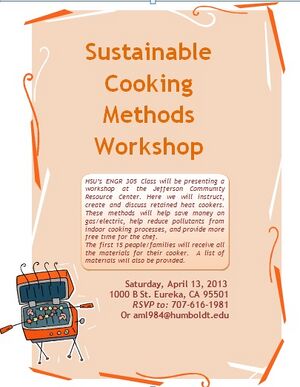
Design
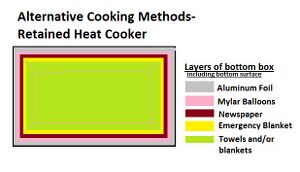
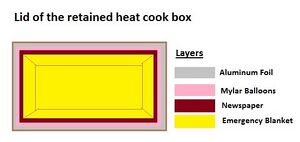
We approached the design of this project with two angles: The first was the design of an easy-to-build retained heat cooker, the second was designing and planning how we would run our community workshop.
Prototype
A prototype was initially constructed with hot glue and corks. But after taking into account the feasibility of the projects materials and work time. We found our workshop would be too long and too costly. After this another design needed to be found. After consulting a chart of R-Values we found that Mylar and newspaper were excellent insulators. We also discovered the 'shell' of our cook box didn't receive any heat from the pot inserted. This made us look into easy alternatives to the planter we initially used. For the remedy to this situation we decided to try a cardboard apple box. Our prototype used foil, Mylar balloons, emergency blankets, newspaper and towels. This worked very well after insulating all sides of the cooker. Once the project is finished we intend to donate the prototype to the Jefferson Community Center.
-
Fig 1: Can retain extremely high temperatures.
-
Fig 2: Great for cooking rice, soups, and stews.
-
Fig 3: The prototype used corks as an insulator.
Workshop Model
While the prototype model worked excellently, there was a major issue. The cost and amount of time involved in its creation were far too high to replicate on a larger scale for a community workshop. We adjusted our model to make it smaller, cheaper and easier to build. In doing this we were able to create 15 retained heat cookers at a low cost. While our prototype model was more effective, these models could easily retain heat and cook meals in a similar manner to a slow cooker. The ease of construction was a major advantage for the purpose of a community workshop. These were easily constructed in a few simple steps, in addition to this they could be constructed in as little as five minutes. The steps were as follows:
- Take a cardboard produce box, cover all holes in box with duct tape.
- Line the inside of the box with newspaper.
- Add a layer of Aluminum foil over the box (it is good if it goes over the sides of the box).
- The final layer is the Mylar blanket, drape it inside the box, letting it lay out over sides.
- Roll the materials hanging outside the box and use duct tape to put them inside the box so nothing is hanging outside.
- Line only the top of the lid with newspaper.
- Cover the newspaper with foil.
- The basic cooker is now complete.
- NOTE: you should line the main box with blankets and towels when you use the cooker.
A more detailed version of these instructions is available at how to build your own Easy Retained Heat cooker
Workshop Methods
We had a few discussions in regards to the best way to run our workshops. After discussing it thoroughly we decided on methods that would allow one of us to perform the creation of the cooker in front of a group, while the other would walk around the room and help people who needed it. We decided that we would serve food made with a retained heat cooker, and answer questions about the use of the cooker.
Testing Results
Both the prototype and workshop models of our cookers performed excellently. They retained heat and cooked food very well. We discovered that there were several advantages to this cooking method. These included things like a decreased need for water, energy and effort. The fact that the cooker lets very little vapor escape also preserves high levels of flavor and causes dishes to need significantly less spicing. The only disadvantage to these cookers was an increased cooking time. It on average took about 1.5 times longer to cook a dish. This is a minor issue though, because of the fact that one can put their dish in the cooker and just wait for it to finish cooking.
Budget
| Quantity | Material | Source | Cost ($) | Total ($) |
|---|---|---|---|---|
| 15 | Appleboxes | Owned | Owned | 0.00 |
| 1 | Roll of foil | Target | 5.00 | 5.00 |
| 2 | Emergency Blankets | Target | 5.00 | 5.00 |
| 1 | Roll of foil tape | Target | 8.00 | 8.00 |
| 30 | Newspapers | Newspaper Boxes on HSU campus | 0.00 | 0.00 |
| 270 | Sheets Literature | Kinko's Copy Center | 0.08 to 0.12 | 10.00 |
| 100 | Sheets Advertisements | Kinko's Copy Center | 0.08 | 20.00 |
| Ample | Refreshments | SafeWay | 50.00 | 50.00 |
| Total Cost | $98.00 | |||
This proposed budget provided enough materials to create 15 workshop models of the retained heat cooker. The cost was covered out-of-pocket, and due to low attendance some of the extra materials were returned for a refund.
The Workshop
The workshop was held on the planned date of April 13th, at 1 PM. Unfortunately the attendance was one community member, and only one retained heat cooker was distributed. We believe this was due to the date and time of the workshop, as well as the fact that it was a sunny day, and many would not be willing to stay inside. Another issue was trying to balance this as a community workshop and branching out. If brochures were more widely distributed, it could be predicted that we might have had a larger turnout. While we believe that having only one person in attendance was disappointing, we also believe that being able to reach out to that one person was a success, and they could potentially spread this knowledge to more people. During the workshop, we were able to not only educate our attendee, but also discuss their work with the Jefferson Community Center, and learn more about future opportunities for workshops and volunteer days. We finished the workshop at 3 PM.
Workshop Flow
While we only had one attendee, we followed a very well planned out flow to our workshop.
- Introductions - We introduced ourselves and the project, and we gave a basic outline for the day's events.
- Material distribution - Materials were distributed into "packages" for community members to pick up.
- Instruction - As a team, we would walk to and from community members, teaching them about the process involved in making the retained heat cookers.
- Education - We would then educate them on ways to use the cooker, and explain the benefits of using this cooking method.
- Literature distribution - Pamphlets with recipes and information were distributed with the cook boxes.
- Question and Answer period - We answered any questions that attendees had about the cookers, ourselves and other aspects of appropriate technology.
- Final Thanks - Thanked Everyone for their support of our project.
- Clean Up - Cleaned up the room for next use.
Volunteer Work Day Potluck
On May 4th 2013, we returned to the Jefferson Community Center to help provide food for a volunteer work day. We provided a vegetable soup over rice that was prepared with the prototype retained heat cooker. As we served food, we taught people how the retained heat cooker worked, and gave them advice on how to make their own. This day was a great success. The attendance was well over 20 volunteers and many were interested in learning about this method of cooking. While we did not have time to go in depth about the cooker it still allowed for many to learn about this cooking method and look into it further.
-
Fig 1: Many showed up
-
Fig 2: Teaching about retained heat cooking
-
Fig 3: Everyone enjoyed the day
Volunteer Work Day Flow
- As a team we set up our food serving station.
- As we served food, we explained to community volunteers how the cooker worked and how they could create their own.
- If any questions were asked we answered them to the best of our ability.
Conclusion
Successes and Failures
We believe that we had a great deal of success with our project. The main success was the creation of a working retained heat cooker and educating many about its benefits. While we only had one person attend our community workshop, they learned a great amount about retained heat cooking. The next major success came in the form of the volunteer work day. Here we were able to show off a working cooker, serve food from it, and educate the community about the benefits of this cooking method. We also answered many questions the community had. The only major failure was the lack of attendance in regards to our original workshop. We believe that in the future this workshop could be beneficial, especially when the Jefferson Community Center begins to grow to the scale that their vision proposes.
Lessons Learned
- Use door-tags as compared to fliers.
- Insist on more widespread distribution, post fliers at both the North Coast Co-Op and Eureka Natural Foods.
- Distribute publicity at an earlier date to insure more planning time.
- Try to predict for weather, a cloudy day might have more people willing to be inside for a workshop.
- Plan a back-up day if the first workshop has low attendance.
- Don't get discouraged! Even reaching out to one person is the start to teaching a community!
Next Steps
After this experience we would continue to urge appropriate technology students to put on community workshops for the Jefferson Community Center. We will also be very willing to teach more people about retained heat cooking, and how they can create their own retained heat cooker. The prototype model will be donated to the Jefferson Community Center once it has been documented on Appropedia. This will allow members of the community to use it and learn about the benefits of this alternative cooking method.
Team Members
References
- ↑ Wiland, Harry, Dale Bell, and Joseph Agnese. Edens lost & found: how ordinary citizens are restoring our great cities. White River Junction, Vt.: Chelsea Green Pub. Co., 2006. Print.
- ↑ Sarkissian, Wendy, Wiwik Mau, Andrea Cook, Kelvin Walsh, and Steph Vajda. Speakout the step-by-step guide to speakouts and community workshops. London: Earthscan, 2009
- ↑ Mattessich, Paul W., Barbara R. Monsey, and Corinna Roy. Community building: what makes it work : a review of factors influencing successful community building. Saint Paul, Minn.: Amherst H. Wilder Foundation, 1997.
- ↑ Ng, Andrew, and Wing Tong Ng. "Automatic high energy saving cooker." U.S. Patent 6,283,014, issued September 4, 2001.
- ↑ Scherer, Richard M. "Cooking system with closed loop heat transfer means." U.S. Patent 4,660,542, issued April 28, 1987.
- ↑ Kesselheim, Alan S.. Camp cook's companion. Camden, Me.: Ragged Mountain Press/McGraw-Hill, 2002.
